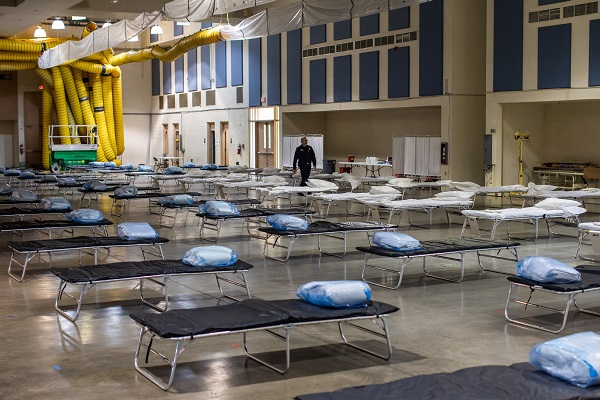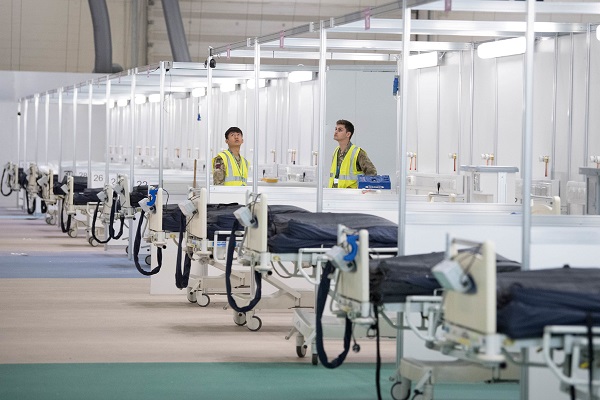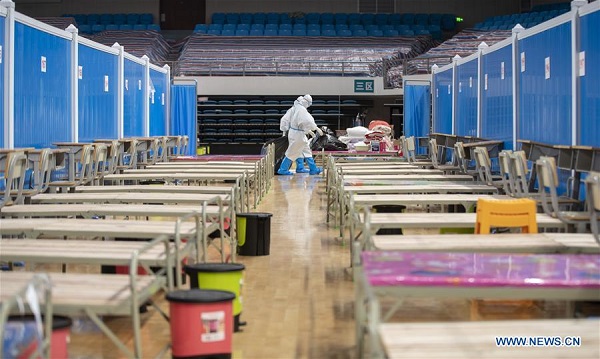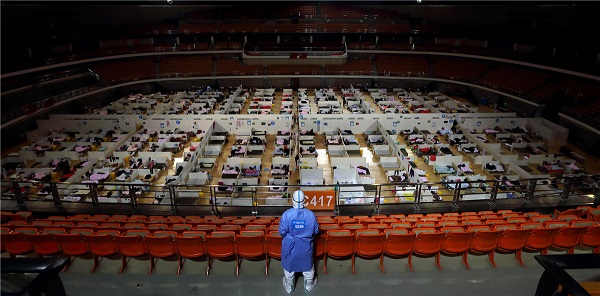Makeshift hospitals point the way

A temporary hospital has been set up by members of the California National Guard in Indio, California, in the United States. Countries around the world are learning from China's experience of turning facilities such as exhibition centers and stadiums into makeshift hospitals to treat COVID-19 patients with mild symptoms. APU GOMES/AFP
Feng Bangli, a resident of Wuhan, Hubei province, which had been the epicenter of the novel coronavirus outbreak on the Chinese mainland, began to have a fever at the end of January and suspected he had been infected with the virus.
Having tried in vain several times to be admitted to a hospital, he gave up and stayed at home, taking drugs prescribed by doctors.
"There were so many patients waiting to see doctors at every hospital, and it was not possible for me to get a bed," he said. He could not be tested, either, due to a shortage of nucleic acid testing kits at that time.
"I called the staff at Chuanglun community where I live. They just agreed to try their best to help," said Feng, a printing house employee.
A week later, Feng was sent by the community staff to a hotel in the city's Wuchang district that was designated for isolation of patients suspected of being infected. He stayed there for three days, receiving a test for the first time and testing positive for the virus. Then he was sent to a makeshift hospital for treatment.
"Without such makeshift hospitals, many COVID-19 patients like me may never have found a bed," said Feng, who has recovered and was discharged from Wuchang Fangcang Hospital, a temporary hospital transformed from a sports stadium, at the end of February after staying there for 12 days.
In total, more than 12,000 COVID-19 patients in Wuhan, the Chinese city hit hardest by the epidemic, received treatment and care at 15 temporary hospitals, which were converted from exhibition halls, sports stadiums and warehouses. This means these hospitals, which mainly receive patients with mild symptoms, accommodated one in every four confirmed COVID-19 patients in the city, said Ma Xiaowei, minister of the National Health Commission.
"Building temporary hospitals was a key decision made in the critical moment when Wuhan was facing a formidable task of epidemic control, and it has played an indispensable role in both prevention and treatment of the disease," he said.

Soldiers and private contractors (not pictured) help prepare the ExCel London centre, which is being made into the temporary NHS Nightingale Hospital, comprising of two wards, each of 2,000 people, to help tackle the coronavirus outbreak, in Newham, London, Britain March 30, 2020. [Photo/Agencies]
The concept of such hospitals has now been embraced worldwide, as nations struggling to provide treatment to increasing numbers of patients are erecting temporary hospitals or repurposing existing venues.
China started to build temporary hospitals on Feb 3 in Wuhan, and two days later, Wuchang Fangcang Hospital was the first to receive patients. The number of cases in the city was sharply increasing then, and hospitals were overwhelmed with patients.
Liu Juan, a community worker at Weiqun community in Wuhan's Jiang'an district, said it was very difficult for people in the community suspected of having the virus to be diagnosed and hospitalized for treatment in early February, due to a lack of beds.
Of all the 23 residents in the community who suspected they had the disease, only three were in a hospital then, with the others isolating themselves at home and taking drugs prescribed by doctors, she said.
Wang Chen, president of the Chinese Academy of Medical Sciences, who advocated for building temporary hospitals, said that only through transforming large existing venues such as sports stadiums and exhibition halls could authorities provide a large number of beds as quickly as possible to receive large numbers of patients.
In addition to providing beds for patients, the hospitals are also ideal isolation sites for patients with mild symptoms, so that those patients will not spread the disease by moving around like they did in residential communities, he said.
With the easing of the epidemic, the temporary hospitals began closing in the beginning of March. Wuchang Fangcang Hospital, which closed on March 10 after its final 49 patients were discharged, was also the last of the 15 hospitals to close.

Medical workers clear the facilities after all patients left the Wuchang temporary hospital in Wuhan, Central China's Hubei province, March 10, 2020. [Photo/Xinhua]
The hospital, with 784 beds, received a total of 1,124 COVID-19 patients with mild symptoms during its 35 days of operation. No patients died in the hospital, and none of its medical staff were infected, according to Renmin Hospital of Wuhan University, its leading operator.
In total, 868 medical workers from 14 medical teams sent from nine provinces and municipalities across China participated in the treatment of patients in the temporary hospital.
'Considerable progress'
"Closing the hospital means we have made considerable progress in epidemic control in Wuhan," said Xu Junmei, vice-president of the hospital. "Temporary hospitals have greatly eased pressure on designated hospitals to receive and treat patients, which made it possible to treat and isolate all people in need. They were the life vessels during the peak of the epidemic."
Following strict lockdown measures that have lasted for more than two months, the epidemic has been brought under control in the city.
There have been no reported new cases of COVID-19 in the city over most of the past two weeks, and only 31 new cases were reported across the Chinese mainland on Sunday. During the epidemic's peak in mid-February, nearly 4,000 new cases were reported in Wuhan each day, according to the National Health Commission.
As of Sunday, 50,006 COVID-19 cases were confirmed in Wuhan since the start of the outbreak in December, accounting for more than 60 percent of the total cases on the Chinese mainland, according to the commission.
Feng, once a patient at Wuchang Fangcang Hospital, said that in the first few days after being admitted the beds were always occupied in the section where he stayed. Empty beds started to become available a week later, when patients recovered and left and the number of new patients decreased, he said.
"Only patients who tested positive for the virus could be admitted," he said. "Most patients had mild symptoms, such as cough and fever, but some of them did not show any abnormalities at all."

Ni Xiaohui overlooks the makeshift hospital where he and his colleagues work at in Wuhan, Hubei province in this February 2020 file photo. [Photo by WANG JING/CHINA DAILY]
Feng said doctors and nurses inspected the wards every day, and took patients' temperatures two or three times a day. Sometimes they received blood tests and prescribed drugs, he said. They were provided with good meals, and all the treatment and food was free, he added.
Liu Xiaocui, another resident in Wuhan who was discharged from Dunkou Fangcang Hospital in early March, said she started to feel not well in late January, including a headache and throat discomfort. But when she arrived at a regular hospital designated for such patients, she could not be diagnosed due to a lack of virus testing kits.
She was sent by the workers in her residential community to the temporary hospital in mid-February, she said.
"In the first few days, materials in the hospital were in short supply, and sometimes the meals were cold when delivered to us, but all of us could appreciate that it was a tough time," Liu said. "We had good food, including meat, vegetables, fruit and milk every day."
After staying in the hospital for treatment for a few days, Liu said her condition improved and her appetite returned. Before she was discharged from the hospital, she received two nucleic acid tests for the coronavirus, with an interval of 24 hours, and tested negative, she said.
An Shuoyan, a doctor who worked at a temporary hospital built in Wuhan Parlor, a major exhibition complex in Wuhan, said patients in the hospitals generally displayed a positive mood.
"Most of them had very mild symptoms, so they did not have great psychological pressure," said An, from the cardiovascular department of China-Japan Friendship Hospital in Beijing, who was sent to aid the treatment of patients in Wuhan.
"Many of them could not find a bed in a regular hospital, so they felt very glad to finally have a bed," she said. "Although living conditions could not compare with regular hospitals, most of them did not complain and cooperated well with doctors and nurses for treatment."
Although not regular hospitals, the temporary hospitals were built to the standard required for infectious diseases and were equipped with all necessities, such as testing machines and mechanical ventilation machines for patients, she said.
Useful insights
Since there are no known effective drugs for COVID-19, An and other doctors treated the patients with symptom-relieving therapies. In the event patients' conditions deteriorated, they would be transferred to designated hospitals for more intensive treatment, she said.
Wang, president of the Chinese Academy of Medical Sciences, said China's experience in epidemic control by building such temporary hospitals may provide useful insights for some other countries that are experiencing rapid increases in the number of patients.
In addition, authorities in China and other countries can consider formulating design standards for buildings such as major exhibition centers, stadiums and warehouses, so they can be converted into temporary hospitals within 24 hours in case of an emergency, Wang said.
"The massive use of temporary hospitals is of marked significance in China's medical rescue history," said Ma, the National Health Commission minister. "It also provides a new mode for us to cope with major public health emergencies to swiftly organize and expand medical resources."
